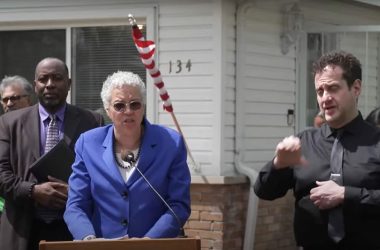IEMA, local emergency management officials to provide preparedness tips for tornadoes, severe storms and flooding
SPRINGFIELD–(ENEWSPF)–February 28, 2014. Governor Pat Quinn today proclaimed March as Severe Weather Preparedness Month in Illinois and encouraged Illinois citizens to take steps to be better prepared for tornadoes, severe thunderstorms and flooding. During March, the Illinois Emergency Management Agency (IEMA) will join with the National Weather Service (NWS) and local emergency management agencies to increase awareness of these severe weather hazards.
“While we’re currently in the deep freeze with more snow on the way, the Nov. 17 deadly tornado outbreak and several tornadoes last week prove that tornadoes can happen any time of the year,” Governor Quinn said. “We can’t prevent dangerous storms from occurring, but we can arm ourselves with information, plans and supplies that could save lives during a disaster.”
Illinois experienced 54 tornadoes in 2013, which resulted in eight fatalities, 187 injuries and widespread destruction to more than 2,000 homes, businesses and public property. Twenty-five of those tornadoes, including two EF 4 tornadoes, occurred on Nov. 17. Historic flooding also impacted nearly half of Illinois counties last spring. Thirty-five counties received federal assistance to help people affected by the flooding and 40 counties received federal aid to help local governments recoup flood-related expenses.
“Today’s technology provides better severe weather forecasts and offers many ways for people to get warnings in time to take shelter,” said Jonathon Monken, director of the Illinois Emergency Management Agency (IEMA). “NOAA weather alert radios, cell phone weather apps, outdoor warning sirens and TV and radio broadcasts are just some of the methods for receiving weather warnings. But it’s up to all of us to heed these warnings.”
The NWS and state and local emergency management officials strongly encourage people to have a National Oceanic and Atmospheric Administration (NOAA) Weather Radio-All Hazards with battery backup, a tone-alert feature and Specific Area Message Encoding (SAME) technology, which allows the radio to be programmed to receive alerts for specified counties.
When an alert is issued for the programmed area, the device will sound a warning alarm tone followed by the broadcast message. Besides weather information, the NWS also broadcasts warnings and post-event information for all types of hazards, including natural, environmental and public safety hazards, such as earthquakes, chemical spills and AMBER alerts.
IEMA and the NWS developed a Severe Weather Preparedness Guide, which provides information about tornadoes, severe storms, lightning and flooding along with recommended actions to take before, during and after each of these weather events.
The guide also includes definitions of important weather terms, including watches, warnings and advisories and a list of items needed for a family emergency supply kit. It is available on the Ready Illinois website at www.Ready.Illinois.gov or by calling (217) 785-9925. Preparedness tips and information are also available through the Ready Illinois Facebook Page (www.facebook.com/ReadyIllinois) and Twitter Page (twitter.com/ReadyIllinois).
“Family and business preparedness, close monitoring of severe weather threats, and taking protective actions made a big difference in minimizing the death toll from the intense tornadoes last Nov. 17,” said Chris Miller, warning coordination meteorologist with the NWS in Lincoln. “Now is the time to prepare yourself, your family, your business or any place people gather before severe storms impact Illinois again.”
Miller said the annual statewide tornado drill will be held Tuesday, March 4 at 10 a.m. At that time, Illinois NWS offices will send an actual tornado warning as a test to local media outlets through the Emergency Alert System (EAS), as well as to those with weather alert radios. People are encouraged to use this time to practice their tornado safety plans at home, schools and businesses. Many local communities also will test their outdoor warning sirens during this drill.
Source: illinois.gov








